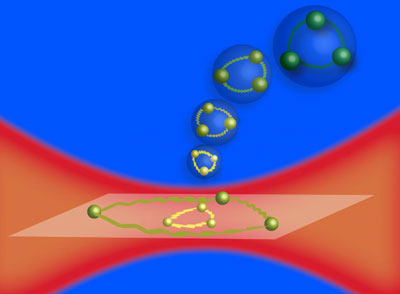| Posted: Sep 16, 2014 |
The fate of the Efimov trimer under confinement
|
|
(Nanowerk News) Recent advances in the manipulation of atoms with lasers and magnetic fields has allowed the creation of trapped, ultracold atomic gases, with temperatures that are arguably the lowest in the universe. At such extremely low temperatures, the gas enters the quantum regime where the atoms no longer behave like classical particles. In this case, the geometry of the system and any constraints on the atoms’ motion have a large impact on the overall behaviour.
|
|
A general rule of thumb is that atoms are more likely to cluster and bind together when they are confined to a plane and their motion is restricted. However, one system dramatically defies this expectation: a gas of bosonic atoms, famous for exhibiting the phenomena of Bose-Einstein condensation and superfluidity.
|
|
In three-dimensional free space, three identical bosons may form an infinite series of configurations, the so-called Efimov trimers, in which three particles can bind even when their two-body attraction is not strong enough to allow two bosons to pair. On the other hand, it is known that confining the atoms’ motion to two dimensions yields only two bound trimers.
|
|
Now, Dr Meera Parish and collaborators have resolved the question of how such a system evolves from infinitely many trimers to exactly two trimers as the atoms become confined to a plane ("Efimov Trimers under Strong Confinement").
|
 |
| Trimers are confined to a plane using lasers and magnets. In free space, there can be infinitely many different types of trimers, while in the plane there are only two. (Figure courtesy of Nerea Grisalena)
|
|
Dr Parish and collaborators have theoretically studied three identical bosonic atoms with attractive short-range interactions that are subjected to a tight harmonic confinement along one direction. By computing the energy spectrum and the aspect ratios of the trimers, they have demonstrated that an arbitrarily weak confinement breaks the weakest bound trimers, while at the same time it stabilises two trimers for even the faintest attraction. In addition, they have derived an effective three-body potential that displays a repulsive barrier at short distances. This potential should result in a suppression of the losses that typically plague strongly interacting, three-dimensional ultracold Bose gases. Thus, strong confinement could be used to engineer more stable Efimov-like trimers, which have so far proved elusive.
|
|
As well as providing new fundamental insights into this prototypical few-body problem, this result has important implications for on-going atomic experiments aimed at detecting universality in the three-body system, and it opens new avenues towards the realisation of long-lived many-body states of trimers. Such trimer states would allow one to investigate non-trivial correlations in many-body systems and they provide another element in the ‘toolbox’ for quantum simulation using cold atoms.
|

